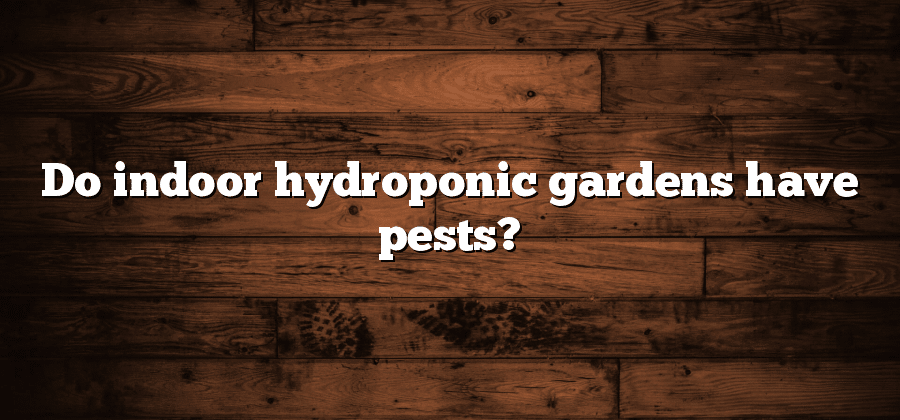Understanding the Potential for Pests in Indoor Hydroponic Gardens
Indoor hydroponic gardens have gained popularity in recent years as a sustainable and efficient method of growing crops. However, along with the many benefits of this system, there is also the potential for pests to infiltrate and harm the plants. Understanding the potential for pests in indoor hydroponic gardens is crucial for gardeners to maintain the health and productivity of their crops.
One of the main reasons why pests can become a problem in indoor hydroponic gardens is the controlled environment that these systems provide. The absence of natural predators and the artificially created conditions can create a favorable environment for pests to thrive. Additionally, the water and nutrient-rich solutions used in hydroponic systems can attract pests like aphids and fungus gnats. Without proper preventive measures, these pests can quickly establish a foothold and multiply, causing significant damage to the plants. Gardeners must be vigilant and proactive in implementing strategies to minimize the risk of pest infestations in their indoor hydroponic gardens.
Identifying Common Pests in Indoor Hydroponic Environments
There are several common pests that can infest indoor hydroponic environments and negatively impact crop production. One such pest is the aphid, a small insect that feeds on plant sap and reproduces rapidly. Aphids can quickly spread throughout a hydroponic garden and cause damage by stunting plant growth and transmitting viruses. Another common pest is the fungus gnat, a tiny fly that lays its eggs in the growing medium. The larvae of fungus gnats feed on plant roots, leading to poor nutrient uptake and weakened plants. Other pests such as spider mites, thrips, and whiteflies can also be problematic in indoor hydroponic gardens. Monitoring and early detection are crucial in identifying these common pests before they can cause significant damage. It is important for hydroponic growers to regularly inspect their plants for any signs of infestation and take immediate action to prevent the pests from spreading.
Impact of Pests on Indoor Hydroponic Crop Quality
Pests can have a significant impact on the quality of crops in indoor hydroponic gardens. These unwanted intruders, such as aphids, spider mites, and whiteflies, can cause damage to the plants by feeding on their foliage and sucking the sap from the leaves. This can result in stunted growth, wilted leaves, and reduced overall crop productivity. Not only do pests physically harm the plants, but they can also introduce diseases and pathogens into the hydroponic system, further jeopardizing the health and quality of the crops.
In addition to the direct damage caused by pests, their presence can also disrupt the balance of the entire hydroponic system. Pests can alter the nutrient uptake of the plants, leading to nutrient deficiencies or imbalances. This can affect the flavor, texture, and nutritional value of the harvested produce. Moreover, the stress caused by pest infestations can weaken the plants, making them more susceptible to environmental challenges such as temperature fluctuations or humidity extremes. Overall, the impact of pests on indoor hydroponic crop quality is a critical concern for growers, and effective pest management strategies are essential for maintaining high-yielding, healthy, and marketable crops.
Preventive Measures to Minimize Pest Infestations in Indoor Hydroponic Gardens
Preventing pest infestations in indoor hydroponic gardens is crucial for ensuring the health and productivity of the crops. By implementing a few key preventive measures, gardeners can significantly minimize the risk of pests infiltrating their hydroponic systems.
First and foremost, maintaining a clean and sterile environment is essential. Regularly clean all equipment, surfaces, and containers used in the hydroponic system to eliminate any potential breeding grounds for pests. This includes removing any decaying organic matter, such as dead plant material or uneaten roots, as they can attract pests. Additionally, proper sanitation practices, such as washing hands thoroughly before handling plants or equipment, can also play a vital role in preventing pest infestations. By consistently practicing cleanliness and hygiene, gardeners can create an inhospitable environment for pests to flourish.
Another effective preventive measure is implementing a system of physical barriers. This involves installing insect screens or mesh netting to restrict pests from entering the indoor garden space. These barriers are particularly useful for preventing flying insects, such as aphids or whiteflies, from accessing the hydroponic system. Regularly inspect the screens for any tears or gaps and promptly repair or replace them to maintain their efficacy. By utilizing physical barriers, gardeners can significantly reduce the likelihood of pests entering the indoor hydroponic garden and causing damage to the crops.
Natural Pest Control Methods for Indoor Hydroponic Systems
Indoor hydroponic systems offer a controlled environment for growing crops without soil, but they are not immune to pest infestations. Fortunately, there are natural pest control methods that can be implemented to keep these unwanted guests at bay. These methods focus on using organic and eco-friendly solutions, ensuring the safety of the plants and the environment.
One effective natural pest control method for indoor hydroponic systems is the use of beneficial insects. These insects, such as ladybugs and lacewings, prey on common pests like aphids, thrips, and spider mites. By introducing these beneficial insects into the hydroponic garden, they can help maintain a balance in the ecosystem and provide natural pest control. Additionally, sticky traps can be employed to catch flying pests like whiteflies and fungus gnats. These traps act as a barrier, preventing them from reaching the plants and causing damage.






